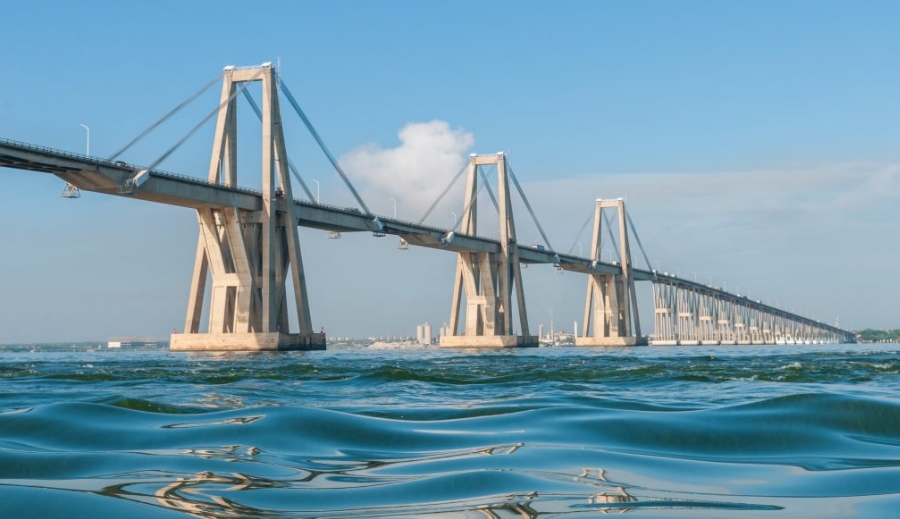
The dangers of using prestressed concrete stays have been highlighted by the Genoa Bridge collapse How safe is the General Rafael Urdaneta Bridge amid rumours that maintenance has been neglected with no safety inspections for decades Is this the beginning of the end for all Riccardo Morandi designed bridges? Described as the “Twin” of the Genoa Bridge, the Venezuelan government is undertaking an immediate safety review - what will this reveal?
Named after a Venezuelan war hero, the General Rafael Urdaneta Bridge is situated in western Venezuela. It connects Maracaibo with the rest of the country, stretching more than 8 km over Lake Maracaibo. The bridge has been in the news of late with extensive focus on Italian engineer Riccardo Morandi who not only designed the General Rafael Urdaneta Bridge but also the Genoa Bridge which collapsed in 2018. This renewed focus on Riccardo Morandi, seen as a revolutionary bridge designer in his day, has laid bare a number of major problems and a revisiting of the Rafael Urdaneta Bridge collapse in 1964.
Urdaneta Bridge collapse Design and construction of the General Rafael Urdaneta Bridge
Construction of the General Rafael Urdaneta Bridge began back in 1958 with the structure open to the public on 24 August 1962. After being put out to tender the Venezuelan authorities decided to go for the only prestressed concrete design which was presented by Riccardo Morandi. Initially, it was thought that the prestressed concrete design would lead to reduced maintenance and reduced general wear and tear. However, there is evidence to suggest this is not the case.
The bridge itself is just over 8.5 km in length (5.4 miles) from shore to shore and is supported by five main spans. The five spans which make up the bridge structure are supported by an array of towers each of which is 92 m in height, laying across 134 support pillars which are anchored to a depth of 60 m. The bridge is an integral part of the local highway system carrying an average of 45,000 vehicles a day but there are now serious concerns about the prestressed concrete stays.
Riccardo Morandi bridge design signature
Back in the 1950s, when Italian civil engineer Riccardo Morandi began his career in bridge design, he had already amassed great knowledge about the use of prestressed concrete. As a consequence, many of his bridges around the world incorporate prestressed concrete stays as opposed to the traditional steel cable variety. His designs are also renowned for the relatively small number of stays per support tower. However, there have been recent concerns that a miscalculation of the impact of viscosity on the prestressed concrete may have created a fatal flaw in the Genoa Bridge and possibly the General Rafael Urdaneta Bridge.
While Riccardo Morandi died back in 1989, in 1979 he produced a report on the Genoa Bridge suggesting that pollution from the sea air and a local steel plant was impacting the strength and durability of the prestressed concrete stays. Unfortunately, on 14 August 2018 his greatest fears came to fruition when the Genoa Bridge collapsed leading to the death of more than 40 people. General Rafael Urdaneta Bridge Collapse
It is worth noting that in 1964, just two years after the bridge was opened, a tanker passing under the bridge collided with one of the support structures. This led to a partial General Rafael Urdaneta Bridge collapse and the death of seven people. While the bridge was eventually repaired and declared safe to reopen, a second cable stayed bridge would appear to have been on the cards since 1982. There have been various studies on a new bridge, expected to cost around $440 million, but so far nothing has been set in stone.
While there was nothing at the time to suggest the prestressed concrete stays were in anyway implicit in the partial collapse of the bridge, opinion is changing after the Genoa Bridge collapse. It would appear even in light of the General Rafael Urdaneta Bridge collapse the structure has received little in the way of maintenance over the years with suggestions there have been no structural inspections for “decades”. Press comment also suggests that the vital bridge crossing weighing system has not been working properly for many years and there are now serious concerns about the safety and viability of the structure. The Venezuelan government is also under pressure after a recent fire on the bridge destroyed an electricity transformer cutting power supplies to millions of homes in Venezuela. Refuting allegations that a lack of maintenance of the bridge led to the transformer fire, this is becoming something of a political dogfight for the Venezuelan authorities. New study after Genoa Bridge collapse
The Venezuelan government has already announced plans for a new review of the General Rafael Urdaneta Bridge amid concerns that the bridge was constructed using identical materials to that in the Genoa Bridge. If, as many believe, the prestressed concrete stays played an integral part in the collapse of the Genoa Bridge this will cause a significant headache for the Venezuelan authorities. The cost of a replacement bridge has been put at $440 million – which would need to be privately financed.
While it makes perfect sense to undertake a new review of the General Rafael Urdaneta Bridge, there are serious concerns this could expose widespread negligence with regards to bridge maintenance and safety inspections. Described as the “Twin of the Genoa Bridge” many believe that the days of the General Rafael Urdaneta Bridge are already numbered. In the meantime, can the Venezuelan government guarantee the safe well-being of those still using the bridge?





 Customer service 1
Customer service 1  Customer service 2
Customer service 2